Apparel Statistics 2024 By Trends, Fashion, Culture
At Market.us News, we strive to bring you the most accurate and up-to-date information by utilizing a variety of resources, including paid and free sources, primary research, and phone interviews. Our data is available to the public free of charge, and we encourage you to use it to inform your personal or business decisions. If you choose to republish our data on your own website, we simply ask that you provide a proper citation or link back to the respective page on Market.us News. We appreciate your support and look forward to continuing to provide valuable insights for our audience.
Table of Contents
- Introduction
- Editor’s Choice
- Global Apparel Industry Statistics
- Apparel E-commerce Statistics
- Trends by Weekly Distribution
- Online Sales of Apparel Statistics
- Top 10 Apparel Exporting Nations Statistics
- Top 10 Apparel Importing Nations Statistics
- Consumer Trends in Apparel Statistics
- Recent Developments
- Conclusion
- FAQs
Introduction
Apparel Statistics: The basics segment in the apparel industry, covering essentials such as t-shirts and casual wear, plays a crucial role in the global economy. This sector spans from mass to premium markets, meeting diverse consumer needs for affordability and quality.
It’s evolving under the influence of sustainability trends, technological advances in materials, and global supply dynamics. The demand for eco-friendly products, direct-to-consumer sales, personalization, and athleisure wear is prominent.
Despite facing issues like fluctuating material costs and ethical production challenges, the segment offers ample opportunities for innovation in design and sustainability, particularly in burgeoning markets.
The resilience and adaptability of the basics apparel sector, propelled by consumer preferences and tech advancements, underscore its importance in the broader apparel industry’s growth.
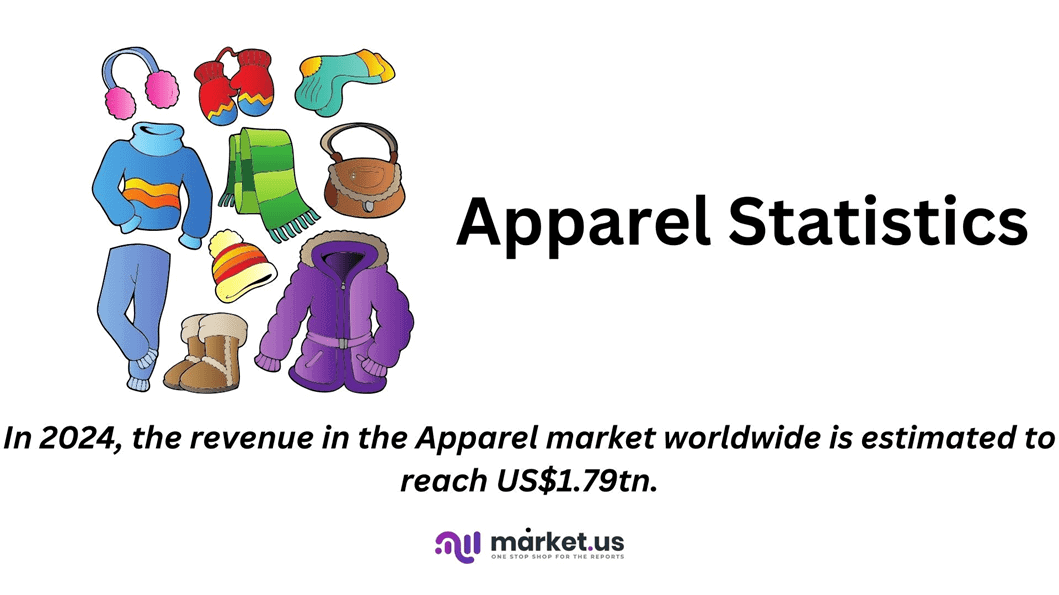
Editor’s Choice
- The Global Decorated Apparel Market size is expected to be worth around USD 96.4 Billion by 2033, from USD 29.2 Billion in 2023, growing at a CAGR of 12.7% during the forecast period from 2024 to 2033.
- Louis Vuitton, headquartered in France, leads the luxury brand valuation with an impressive figure of USD 124,822 million, underscoring its unparalleled market dominance and global recognition.
- The United States stands at the pinnacle of the global apparel market, generating a staggering revenue of USD 351.35 billion in 2023. This positions it as the unequivocal leader in the apparel sector, reflecting its massive consumer base and robust retail ecosystem.
- In 2020, mobile sales constituted 66% of the total e-commerce sales in the fashion industry, signifying a dominant start over desktop sales, which accounted for 34%. This indicates the onset of mobile’s predominance in the digital shopping experience.
- Monday kicks off the week with a notable 13.90% of total fashion e-commerce sales, indicating a strong start as consumers engage in shopping activities perhaps following weekend browsing.
- China leads with an export value of 539,978 million USD, showcasing its dominance in global exports across various sectors.
- United States leads with a staggering import value of 1,200,954 million USD, reflecting its position as one of the world’s largest importers across various industries.

Global Apparel Industry Statistics
Top 10 Most Valuable Luxury Brands Apparel Global Statistics
- Louis Vuitton, headquartered in France, leads the luxury brand valuation with an impressive figure of USD 124,822 million, underscoring its unparalleled market dominance and global recognition.
- Hermès, also based in France, follows with a brand value of USD 76,299 million, reflecting its esteemed position in the luxury goods sector, celebrated for craftsmanship and timeless designs.
- Chanel, another iconic French brand, boasts a valuation of USD 55,939 million, indicative of its enduring influence and legacy in fashion and luxury.
- Gucci, representing Italy’s contribution to the luxury market, holds a brand value of USD 26,306 million, showcasing its innovative designs and strong brand identity.
- Dior, with its rich heritage in haute couture, is valued at USD 11,442 million, highlighting France’s significant role in shaping luxury fashion narratives.
- Cartier, known for its exquisite jewelry and watches, contributes to France’s luxury reputation with a brand value of USD 9,725 million.
- Rolex, based in the United Kingdom, has a brand value of USD 7,899 million, symbolizing its status as a timeless symbol of prestige and precision in the watchmaking industry.
- Tiffany & Co., the United States emblem of luxury jewellery, holds a valuation of USD 6,124 million, reflecting its global appeal and heritage.
- Saint-Laurent/Yves Saint Laurent, another prestigious French brand, has a brand value of USD 6,023 million and is known for its modern and iconic pieces that resonate with fashion connoisseurs.
- Prada, from Italy, with a brand value of USD 4,921 million, rounds out the list, representing its innovative approach to fashion and ability to blend tradition with contemporary aesthetics.
(Source: Statista)
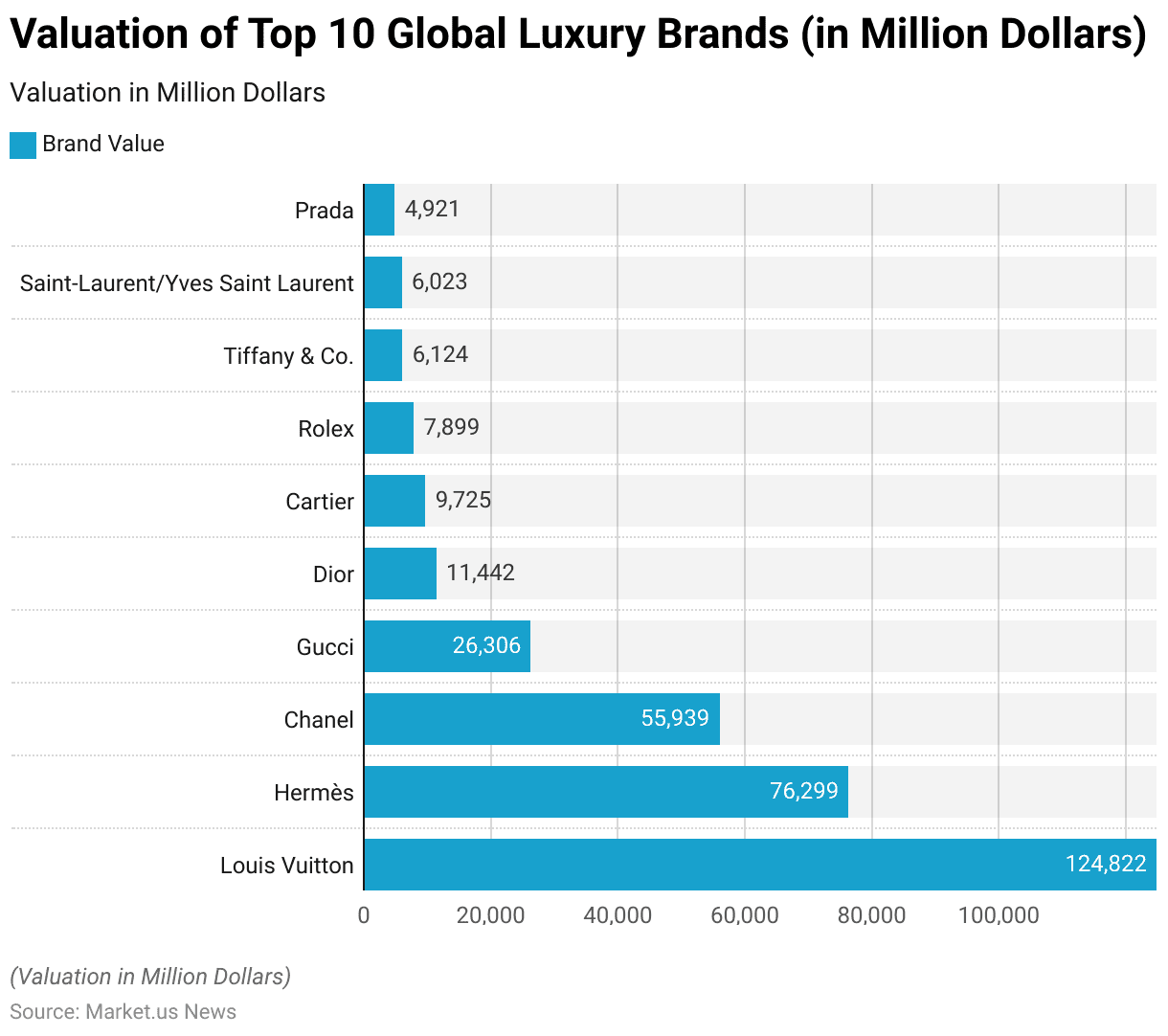
Top 10 Countries Leading the Apparel Market Statistics
- The United States stands at the pinnacle of the global apparel market, generating a staggering revenue of USD 351.35 billion in 2023. This positions it as the unequivocal leader in the apparel sector, reflecting its massive consumer base and robust retail ecosystem.
- Following closely is China, with an apparel market revenue of USD 313.82 billion in 2023. China’s significant manufacturing capacity, coupled with a growing middle class, underscores its critical role in both production and consumption within the global apparel landscape.
- India emerges as a key player with a revenue of USD 101.39 billion, highlighting its rapidly expanding market driven by an increasing population, rising disposable incomes, and a burgeoning fashion consciousness among its citizens.
- Japan, with an apparel market revenue of USD 87.00 billion, showcases its refined fashion sense and high consumer spending power, marking it as a vital market for luxury and high-end apparel brands.
- The United Kingdom, generating USD 82.89 billion in revenue, reflects its strong retail sector and the presence of globally recognized fashion brands, underpinning its significant contribution to the global apparel market.
More Leaders
- Germany’s apparel market, with revenue of USD 72.57 billion, indicates the country’s robust economic framework and consumer preference for quality and sustainability, emphasizing its position in the European apparel market.
- Italy, renowned for its luxury fashion houses and high-quality craftsmanship, contributes USD 57.86 billion to the apparel market, reinforcing its status as a cornerstone of fashion and design.
- France, with a revenue of USD 40.02 billion, is not only the cradle of haute couture but also a significant market for apparel, reflecting its enduring influence on global fashion trends.
- Canada’s market, generating USD 39.71 billion, illustrates the diversity and vitality of its apparel sector, buoyed by a multicultural consumer base and an increasing interest in ethical fashion.
- South Korea, with an apparel market revenue of USD 39.06 billion, is recognized for its dynamic fashion scene and the global influence of its cultural exports, which contribute to its strong performance in the apparel market.
(Source: Statista)
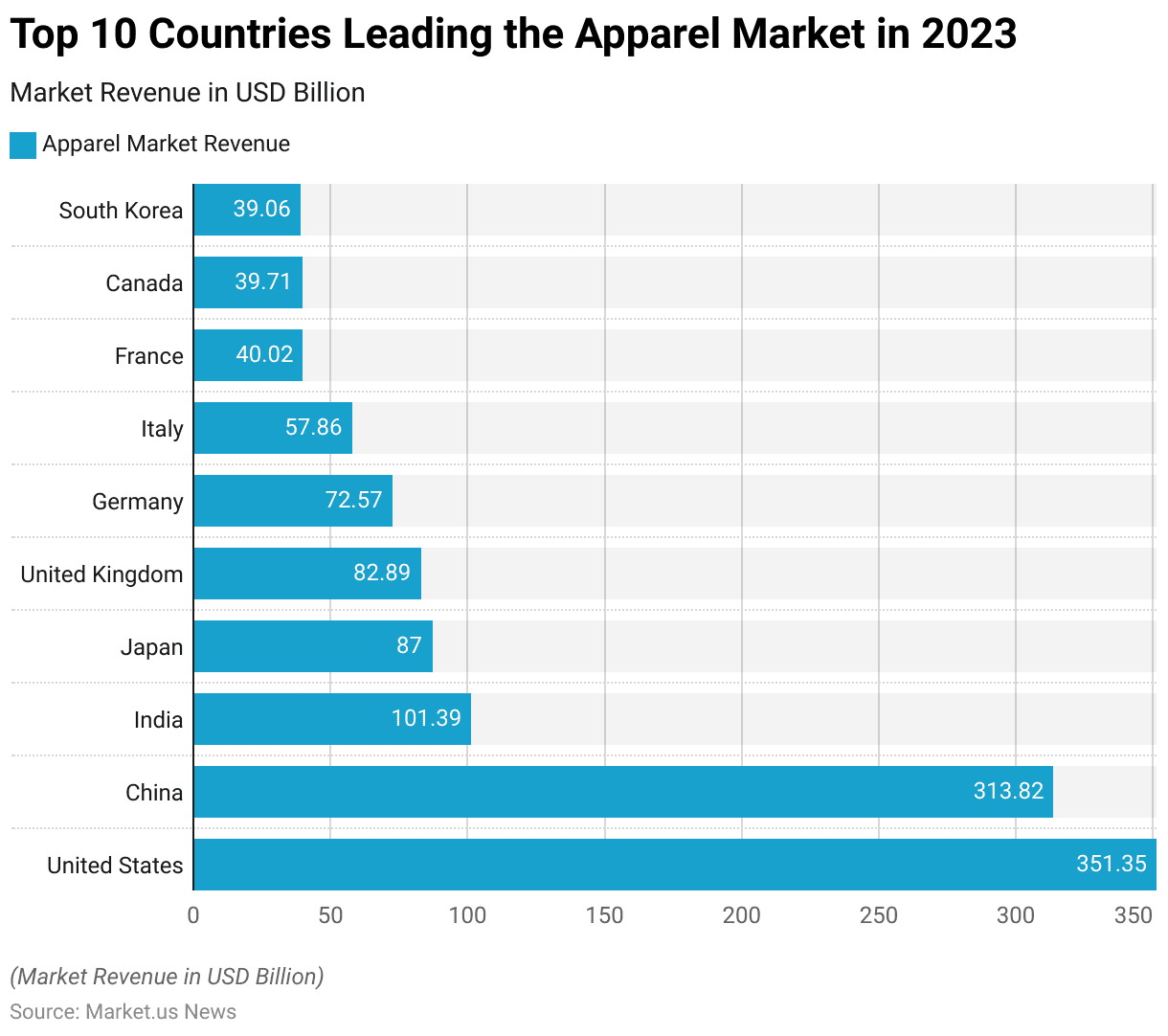
Apparel E-commerce Statistics
By Device
- In 2020, mobile sales constituted 66% of the total e-commerce sales in the fashion industry, signifying a dominant start over desktop sales, which accounted for 34%. This indicates the onset of mobile’s predominance in the digital shopping experience.
- The following year, 2021, saw a further increase in mobile sales, which rose to 69%, while desktop sales dipped to 30%. This trend underlines the escalating importance of mobile-optimized shopping platforms and the need for brands to enhance their mobile e-commerce strategies.
- The gap widened in 2022, with mobile sales climbing to 72%, nearly three-quarters of all fashion e-commerce sales, while desktop sales continued to decrease, settling at 29%. This persistent growth pattern underscores the transformative impact of mobile technology on shopping behaviors and the criticality of mobile-first approaches for retailers.
- These figures reflect a broader digital transformation within the fashion retail sector, where an optimized mobile user experience becomes imperative for capturing consumer interest and driving sales in an increasingly mobile-centric market.
(Source: Salecycle)
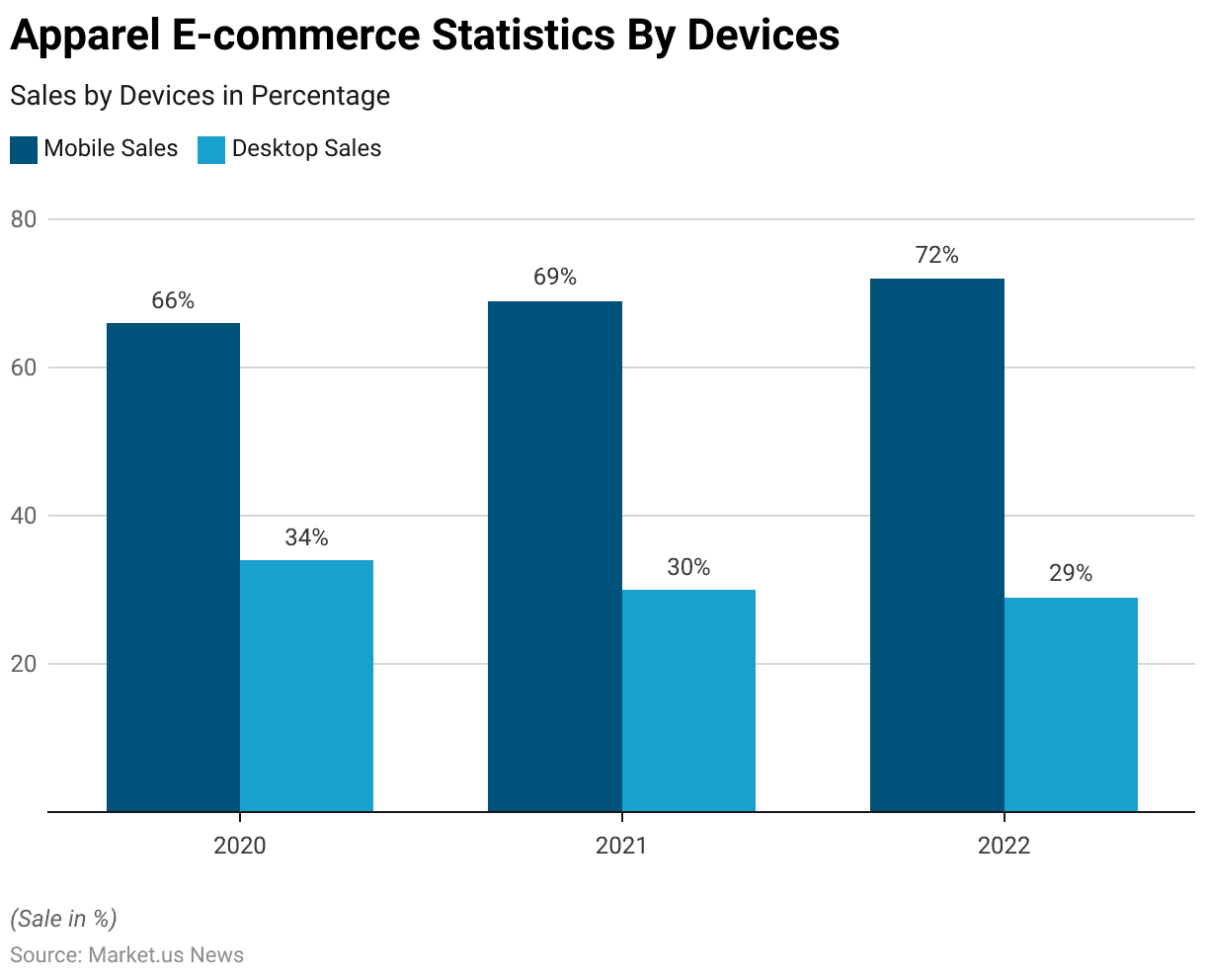
Trends by Weekly Distribution
- Monday kicks off the week with a notable 13.90% of total fashion e-commerce sales, indicating a strong start as consumers engage in shopping activities perhaps following weekend browsing.
- Tuesday sees a slight dip to 13.12%, suggesting a potential normalization of consumer purchasing patterns after the beginning of the workweek.
- Midweek, on Wednesday, there’s a marginal increase to 13.61%, which could indicate mid-week marketing efforts or promotions catching shopper interest.
- Thursday shows a significant spike, claiming the highest weekday percentage at 15.80%, possibly reflecting payday patterns or the anticipation of upcoming weekend events.
- Friday’s share is at 13.89%, slightly down from Thursday’s peak but still robust, as consumers may make last-minute purchases for the weekend.
- Saturday experiences a further reduction to 13.43%, which might be attributed to people spending less time online and more time in physical retail environments or enjoying weekend leisure activities.
- The week concludes with Sunday recording the highest percentage of the week at 16.22%, suggesting that consumers take the day to prepare for the week ahead, engaging in online shopping as a leisure activity or capitalizing on weekend deal closures.
(Source: Salecycle)
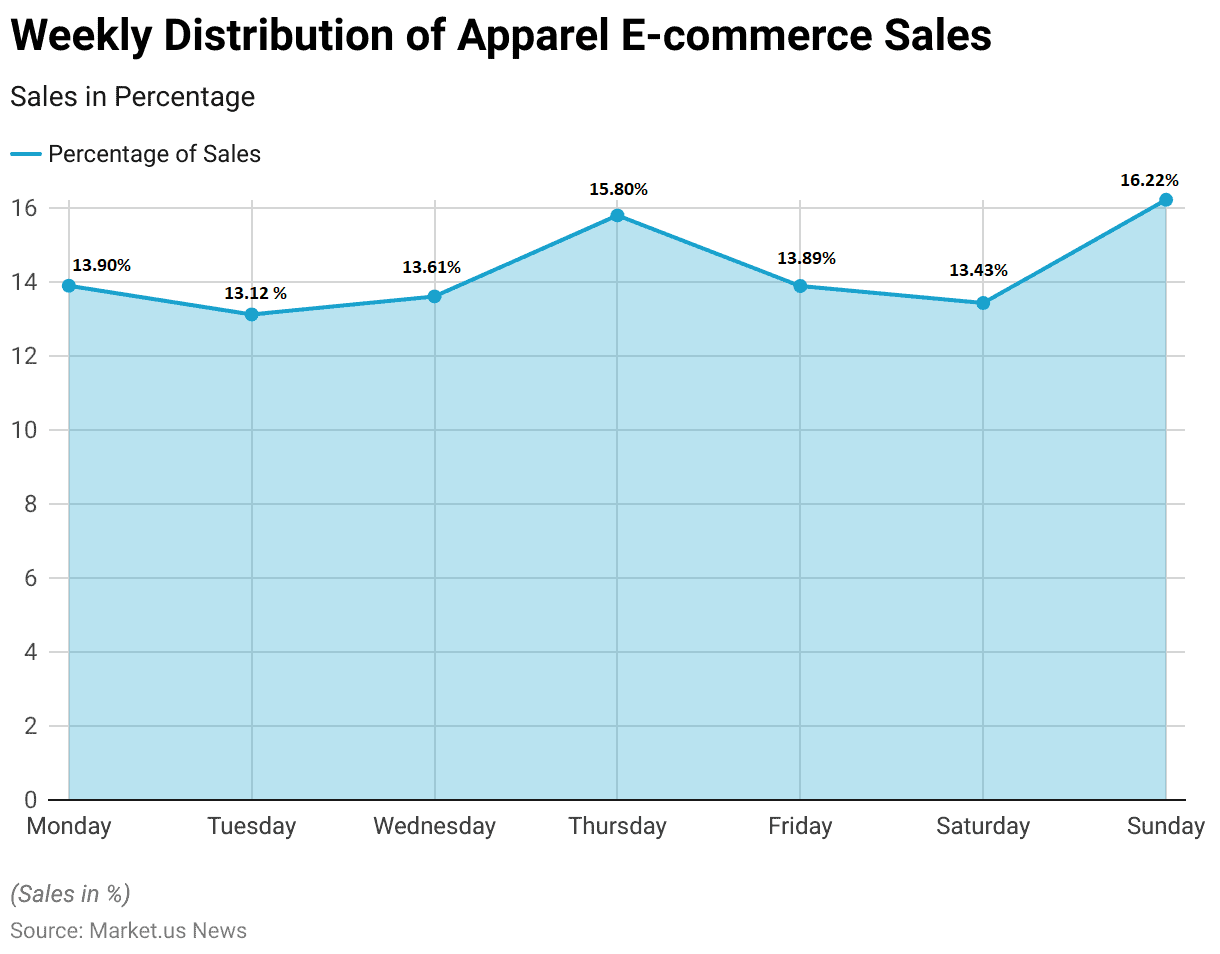
Online Sales of Apparel Statistics
Consumer Segment
- Mobile Device: Within the consumer segment of fashion e-commerce, mobile devices play a dominant role, accounting for a significant majority of online sales at 66.94%. This indicates a strong preference among consumers for shopping on mobile platforms, possibly due to factors such as convenience, ease of use, and accessibility.
- Desktop: While mobile devices lead in terms of sales, desktop usage remains relevant, representing a notable portion of online sales at 33.05%. Despite the growing prevalence of mobile shopping, desktop computers continue to serve as a preferred platform for certain consumers, possibly due to preferences for larger screens, enhanced browsing capabilities, or specific features not fully optimized for mobile devices.
(Source: Salecycle)
Luxury Segment
- Mobile Device: In the luxury segment of fashion e-commerce, mobile devices also play a significant role, accounting for a substantial portion of online sales at 63.88%. This highlights a trend within the luxury market where consumers are increasingly comfortable making high-end purchases through mobile platforms, reflecting the evolving digital landscape and shifting consumer behaviors.
- Desktop: While mobile devices dominate in terms of sales, desktop usage remains noteworthy within the luxury segment, representing a considerable share of online sales at 36.11%. Despite the perception that luxury shopping may be more conducive to desktop experiences due to factors such as product research, detailed imagery, and larger screens, the significant presence of mobile sales in this segment underscores the importance of omnichannel strategies and catering to diverse consumer preferences.
(Source: Salecycle)
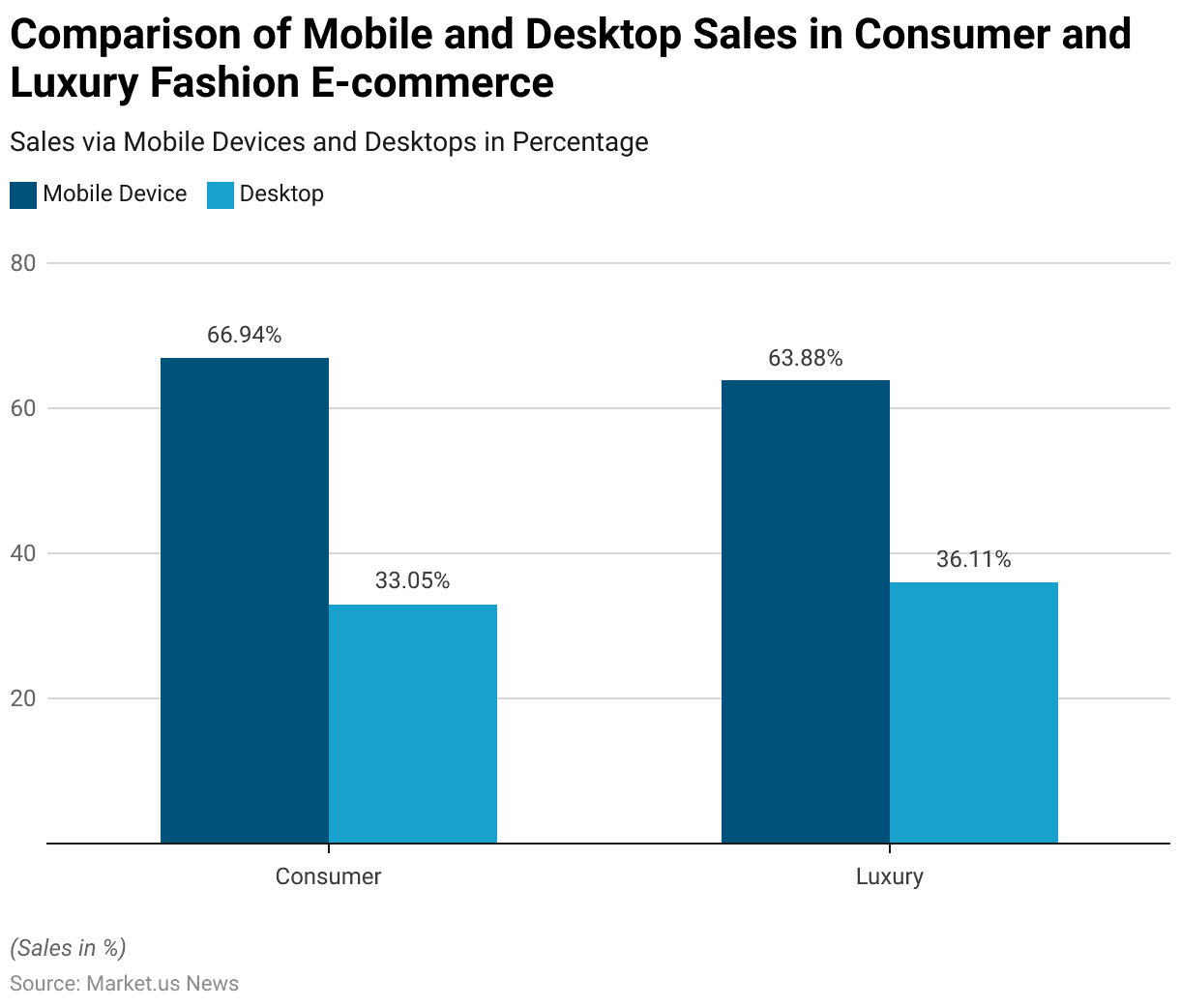
Top 10 Apparel Exporting Nations Statistics
- China leads with an export value of 539,978 million USD, showcasing its dominance in global exports across various sectors.
- Vietnam follows closely behind China with an export value of 332,002 million USD, reflecting its significant role in international trade, particularly in textiles, electronics, and agriculture.
- India ranks third with an export value of 306,509 million USD, highlighting its diverse export portfolio ranging from textiles and pharmaceuticals to software services.
- Sri Lanka represents a notable exporter with an export value of 157,639 million USD, largely driven by its textile and apparel industry.
- Indonesia contributes significantly with an export value of 67,671 million USD, primarily driven by its natural resources, manufacturing, and agriculture sectors.
- Germany maintains a strong position with an export value of 67,359 million USD, underscoring its status as an industrial powerhouse renowned for high-quality engineering and automotive products.
- United States demonstrates its global presence with an export value of 67,252 million USD, driven by a diverse range of industries including technology, aerospace, and agriculture.
- Italy exhibits a robust export performance with an export value of 66,989 million USD, largely fueled by its fashion, automotive, and machinery sectors.
- Spain shows resilience in exports with an export value of 63,948 million USD, bolstered by its tourism, automotive, and agricultural products.
- Singapore rounds up the list with an export value of 61,891 million USD, showcasing its strategic role as a trading hub in Southeast Asia, particularly in electronics, finance, and shipping.
(Source: Volza)
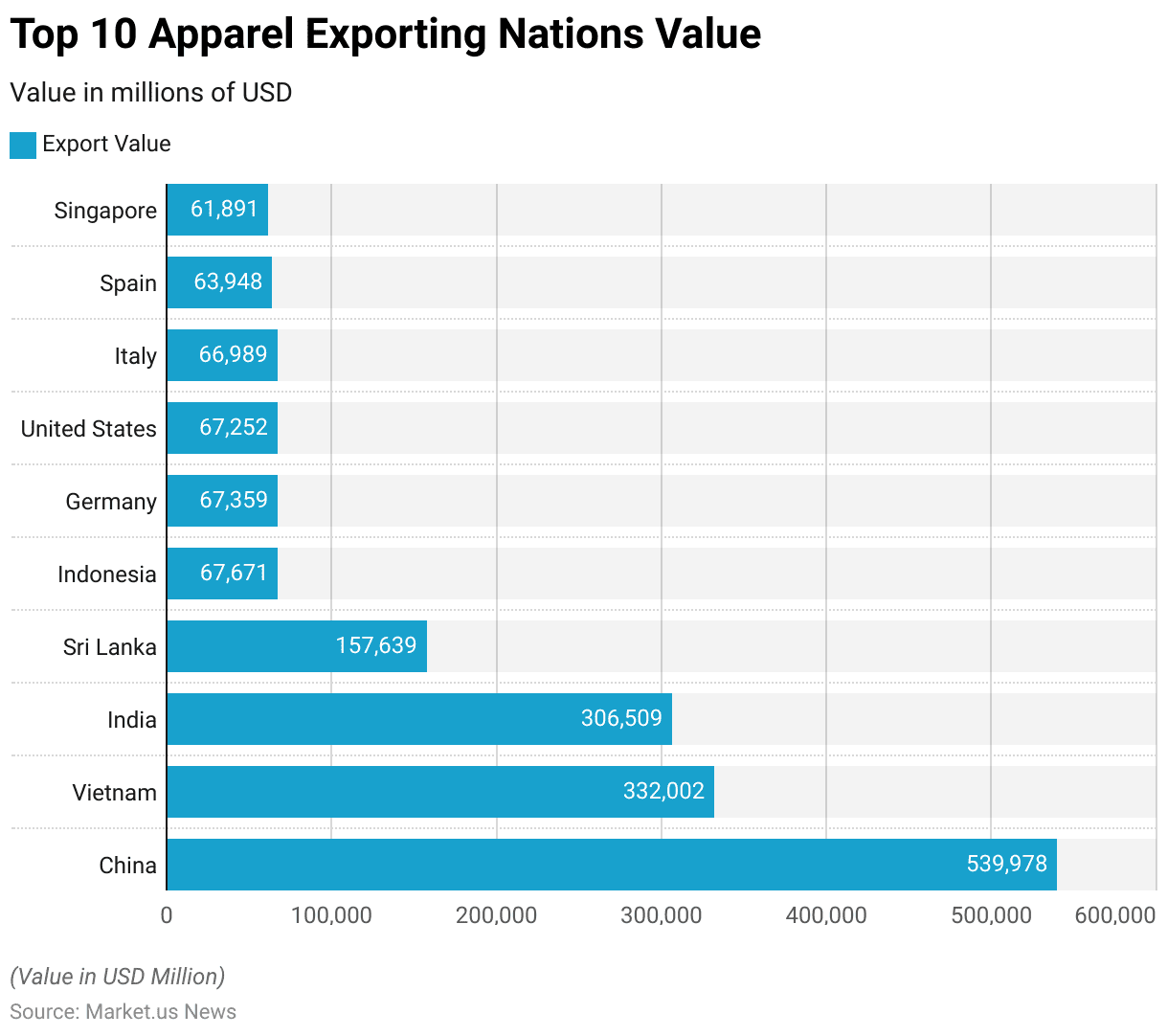
Top 10 Apparel Importing Nations Statistics
- United States leads with a staggering import value of 1,200,954 million USD, reflecting its position as one of the world’s largest importers across various industries.
- Vietnam follows with a significant import value of 210,784 million USD, indicating its role as an emerging market with increasing demand for imported goods, particularly in textiles, electronics, and machinery.
- India ranks third with an import value of 98,907 million USD, highlighting its diverse import requirements ranging from crude oil and electronics to machinery and precious metals.
- Germany maintains a strong position with an import value of 64,165 million USD, showcasing its reliance on imported goods to support its manufacturing and industrial sectors.
- Mexico contributes significantly with an import value of 59,768 million USD, driven by its close economic ties with the United States and its role as a major exporter of automotive, electronics, and machinery products.
- United Kingdom exhibits a substantial import value of 55,781 million USD, reflecting its position as a major trading partner within the European Union and globally.
- Netherlands shows resilience with an import value of 47,748 million USD, largely driven by its role as a transportation and logistics hub in Europe, facilitating trade between European nations and beyond.
- Italy maintains a notable import value of 42,381 million USD, indicating its reliance on imported goods to support its manufacturing, automotive, and fashion industries.
- France exhibits a significant import value of 41,759 million USD, driven by its diverse import requirements across industries such as aerospace, automotive, and pharmaceuticals.
- Spain rounds up the list with an import value of 37,923 million USD, reflecting its reliance on imported goods to support its economy, particularly in sectors such as automotive, machinery, and electronics.
(Source: Volza)
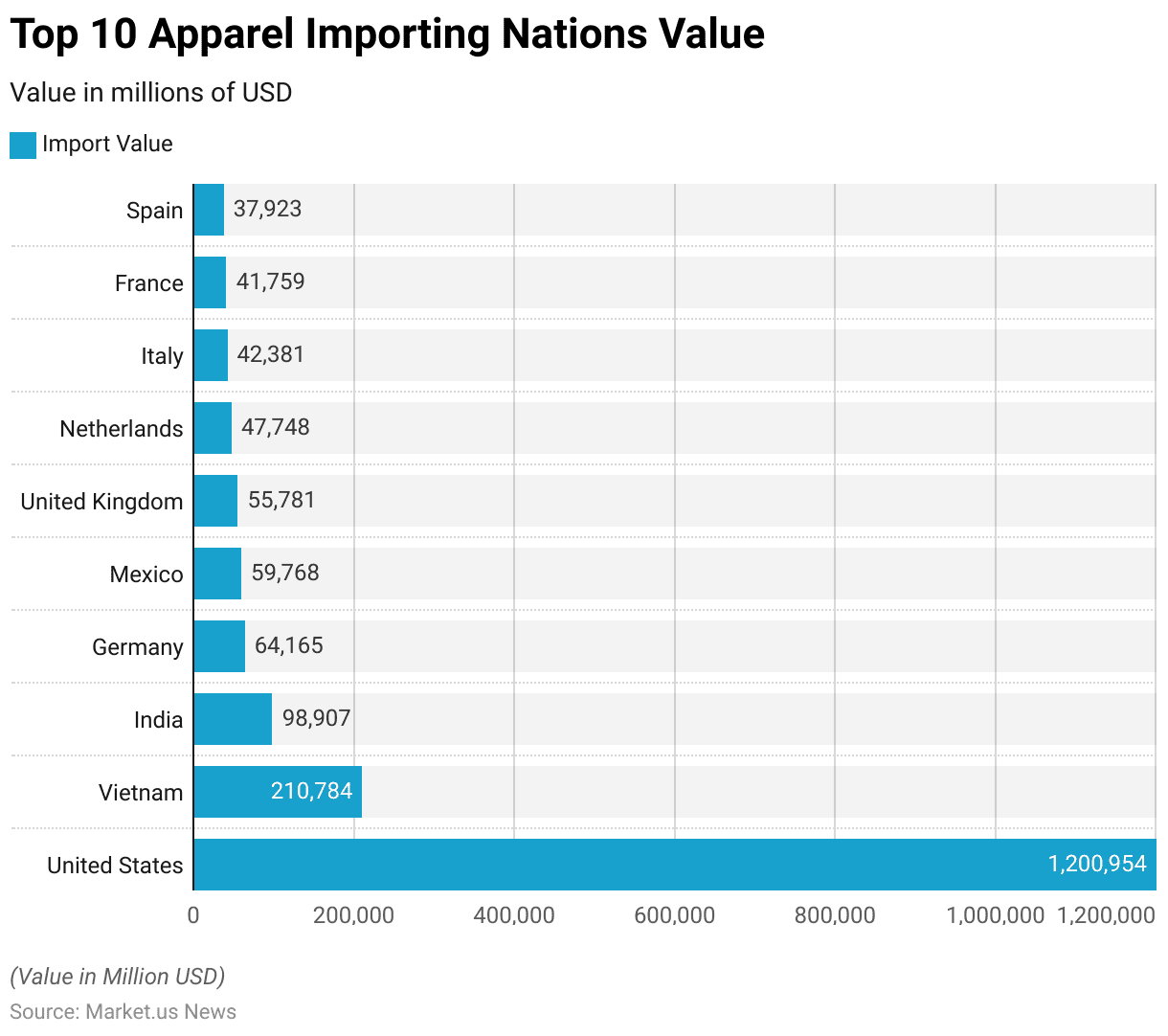
Consumer Trends in Apparel Statistics
Demographic Distribution of Fast Apparel Purchasing Patterns Statistics
- U.S. Gen Z shoppers lead the affinity for fast fashion brands, with a significant 80% preference, yet show no corresponding interest in countries typically associated with fast fashion consumption.
- Italian Millennials also demonstrate a notable preference for fast fashion brands at 60%, aligning with the trend seen in younger demographics.
- Generation Xers in Europe exhibit a 40% preference for fast fashion brands, suggesting a moderate level of engagement with fast fashion.
- Mexican Boomers show the least preference for fast fashion brands among the demographics listed, with only a 20% inclination toward these brands.
- Notably, the preference for fast fashion brands like H&M and Zara is matched with a 60% consumer base in their associated countries, indicating a balanced brand and country association.
- In India, there is a 20% preference for fast fashion brands, coupled with a 40% interest in countries known for fast fashion, hinting at a growing market engagement.
- Uniqlo and China have an equal 20% brand preference, with a higher 60% consumer interest in countries associated with fast fashion, potentially reflecting China’s role as a major consumer and producer in the industry.
(Source: Textile Today)
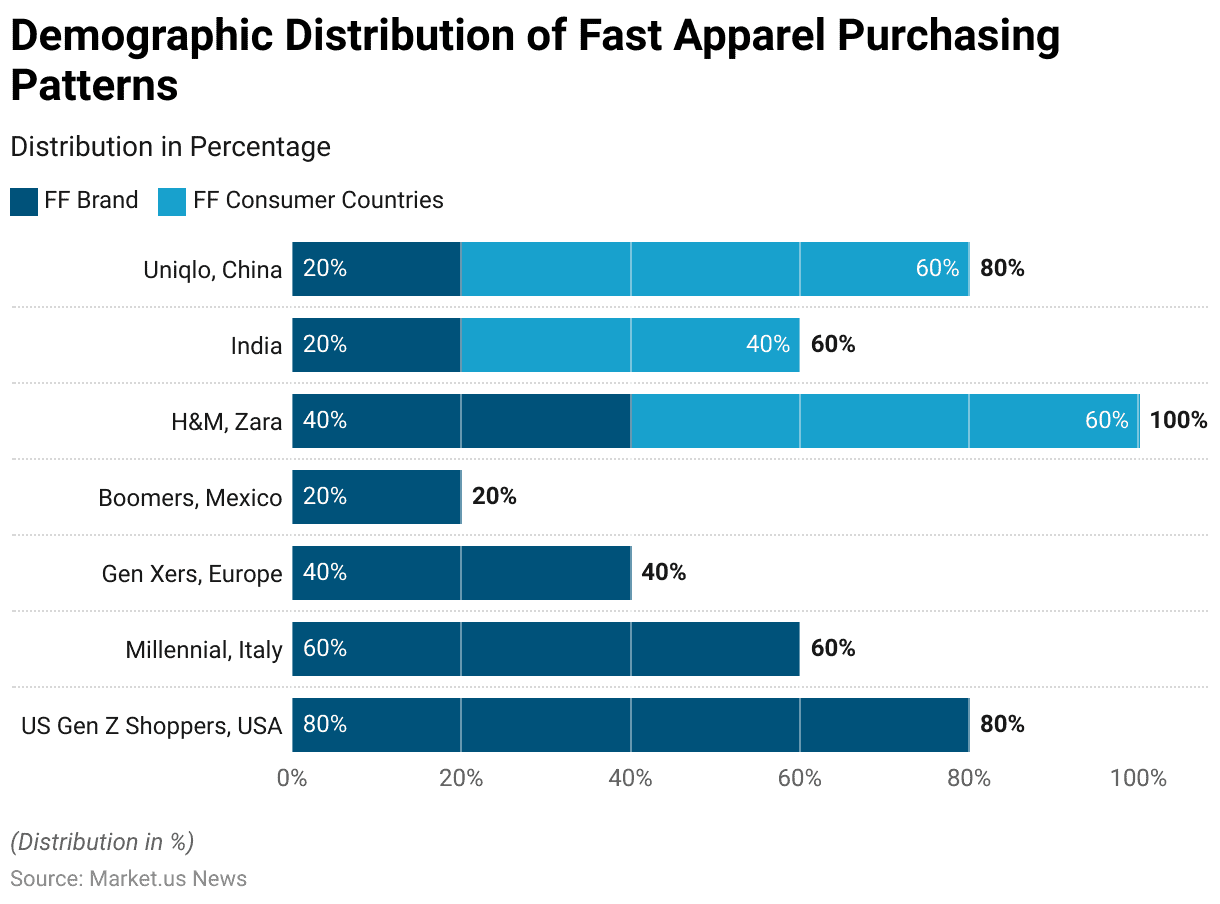
Concerns About Sustainable Apparel Buying Statistics
- In Italy, consumer concerns for sustainable clothing are high, with environmental friendliness and comfort being the primary considerations at 75% and 85%, respectively. Quality concern follows closely at 80%, while fit and price hold 70% and 65% concern levels.
- Mexican consumers mirror the Italian concerns for sustainable clothing, placing a significant emphasis on environmental friendliness and comfort, both at 75% and 85%. Quality concerns stand at 80%, with fit and price at 70% and 65%.
- The Chinese market also shows similar priorities in sustainable apparel, valuing environmental friendliness and comfort (75% and 85%). Quality is a close second at 80%, with fit and price concerns at 70% and 65%.
- India’s statistics align with the other three countries mentioned above, with high importance placed on environmental friendliness (75%) and comfort (85%). Quality concerns are reported at 80%, and fit and price at 70% and 65%.
- In contrast, the U.S. displays a lower emphasis on environmental friendliness at 55%, although comfort remains a significant factor at 75%. Quality concerns and price are at 70% and 60%, respectively, with fit being the least concern at 40%.
- The U.K. follows the U.S. trend with identical percentages across all five categories, indicating a shared consumer profile between the two markets in the context of sustainable clothing.
- Germany exhibits consumer concerns identical to those of the U.S. and U.K., suggesting a consistent pattern across these Western countries regarding the prioritization of comfort over fit when it comes to sustainable clothing.
(Source: Textile Today)
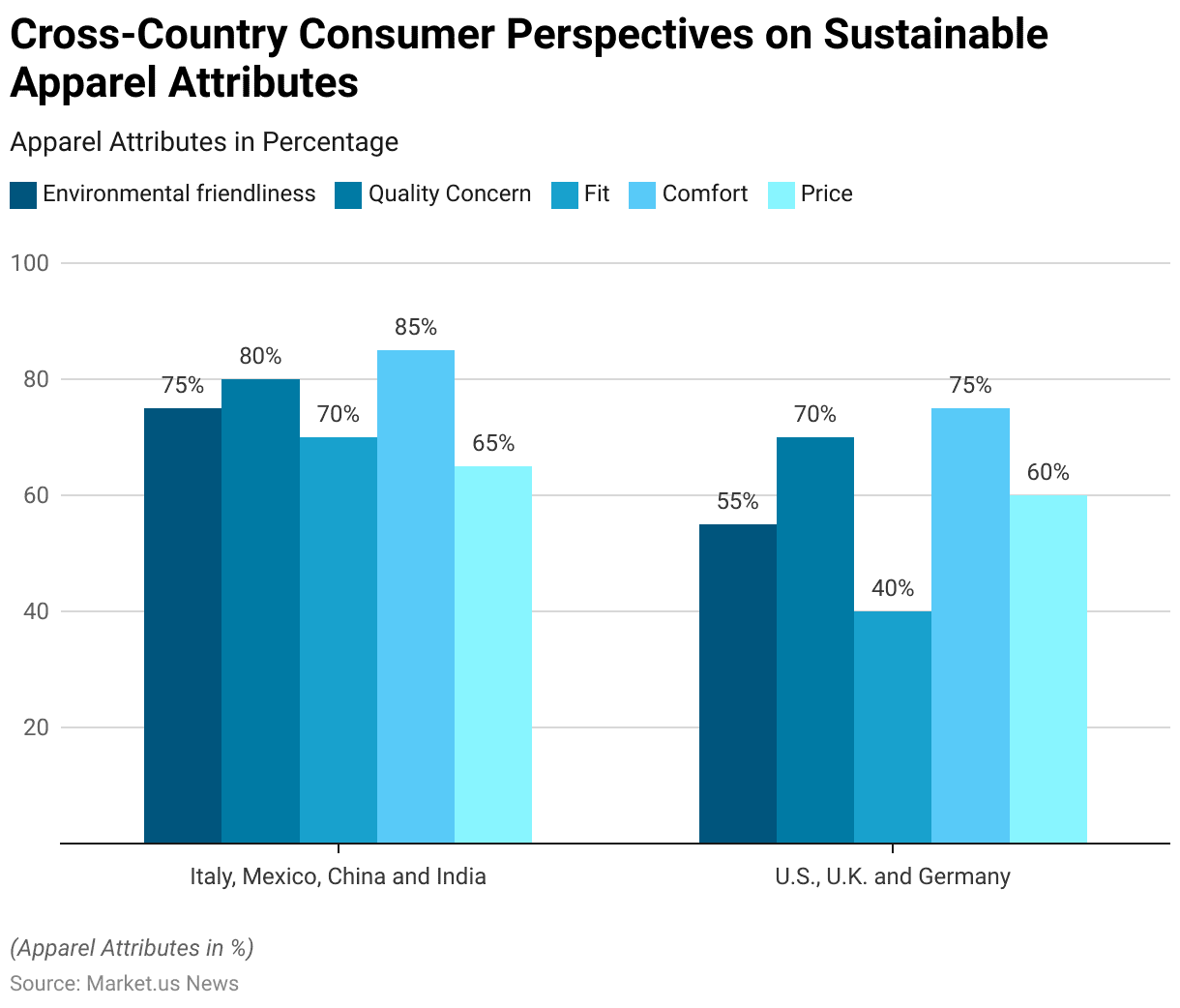
Recent Developments
Acquisitions and Mergers:
- Acquisition of a popular activewear brand by a global fashion retailer in September 2023, expanding their presence in the athleisure market.
- Merger between two leading apparel companies in December 2023, creating a stronger player in the fashion industry and streamlining production and distribution processes.
New Product Launches:
- Introduction of sustainable clothing lines by several major apparel brands in January 2024, responding to consumer demand for eco-friendly and ethical fashion options.
- Launch of innovative smart clothing incorporating wearable technology, such as temperature-regulating fabrics and integrated fitness trackers, by fashion tech startups in March 2024.
Funding Rounds:
- Series C funding round for a direct-to-consumer apparel brand in February 2024, raising $30 million to expand their online presence and invest in marketing initiatives.
- Seed funding for a fashion-tech startup specializing in personalized clothing recommendations in April 2024, securing $8 million for product development and market expansion.
Partnerships and Collaborations:
- Collaboration between a luxury fashion house and a renowned artist in November 2023 to launch a limited-edition capsule collection, leveraging the artist’s aesthetic to create unique apparel pieces.
- Partnership between a fashion retailer and a leading tech company in March 2024 to develop virtual fitting room applications, enhancing the online shopping experience for customers.
Consumer Preferences and Behavior:
- Increasing demand for gender-neutral and inclusive clothing options, prompting apparel brands to diversify their product offerings and marketing strategies.
- Growing interest in sustainable and ethical fashion practices among consumers, influencing purchasing decisions and driving brands to adopt environmentally friendly production methods.
Supply Chain Innovations:
- Adoption of blockchain technology to enhance transparency and traceability in the apparel supply chain, enabling consumers to track the origins and journey of their clothing from production to sale.
- Implementation of on-demand manufacturing and customization capabilities by apparel manufacturers, allowing for more efficient and sustainable production processes while meeting consumer demand for personalized products.
Conclusion
Apparel Statistics – The global apparel market is experiencing growth driven by increasing disposable incomes and the expansion of e-commerce platforms facilitating easy access to a wide range of products.
The fast fashion sector, characterized by quick turnaround and affordable pricing, is particularly influential.
However, sustainability concerns and ethical production are emerging as significant restraining factors, as consumers grow more environmentally conscious.
Recent developments in the industry include a pivot towards sustainable materials, the adoption of circular fashion principles, and technological advancements such as 3D printing and AI-driven trend forecasting, which are set to redefine the future landscape of apparel consumption and production.
FAQs
The apparel industry is seeing a surge in demand for sustainable and ethically sourced materials. Advances in technology have also brought about personalization and on-demand manufacturing. Additionally, athleisure wear continues to be popular, merging comfort with style for everyday wear.
Technology is revolutionizing the apparel market through innovations like 3D printing for on-demand manufacturing, AI for trend prediction and inventory management, and virtual reality fitting rooms. It’s improving supply chain efficiency, reducing waste, and offering a more personalized shopping experience.
Key drivers include rising global income levels, increasing fashion consciousness, and the growth of e-commerce. The influence of social media and influencers has also accelerated the demand for the latest fashion trends, leading to rapid growth in the fast fashion segment.
Yes, there is a growing movement towards sustainability in fashion, with consumers increasingly seeking out brands that prioritize eco-friendly practices, use sustainable materials, and promote ethical labor conditions. This shift is influencing brands to adopt more sustainable business models.
The industry faces challenges such as supply chain disruptions, the need to adapt to sustainable practices, and coping with the fast pace of fashion. The pressure to reduce environmental impact, while maintaining profitability and meeting consumer demand for fast, affordable fashion, remains a significant challenge.
Sources.

Tajammul Pangarkar
Tajammul Pangarkar is a tech blogger that frequently contributes to numerous industry-specific magazines and forums. Tajammul longstanding experience in the fields of mobile technology and industry research is often reflected in his insightful body of work. His interest lies in understanding tech trends, dissecting mobile applications, and in raising a general awareness of technical know-how. When he’s not ruminating about various happenings in the tech world, he can be usually found indulging in his next favorite interest - table tennis.
Latest from Author
- Dropshipping Businesses to Thrive With Rapid Expansion of E-Commerce Platforms
- Dropshipping Statistics 2024 By Location, Sellers, Buyers
- Top 10 Breakfast Cereals Companies | Best Meals Preparation
- Pickleball has Increased Media Coverage and Helped Promote Its Appeal to A Wider Audience
- Pickleball Statistics 2024 By Game, Players, Regions